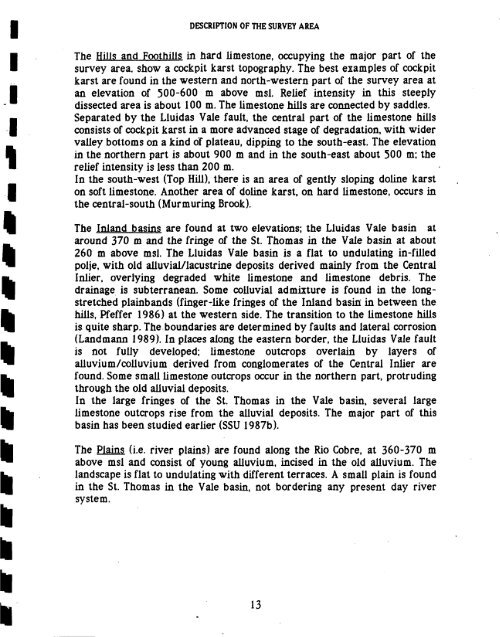Semi-detailed Soil Survey of the LIuidas Vale Area, St. Catherine-St ...
Semi-detailed Soil Survey of the LIuidas Vale Area, St. Catherine-St ...
Semi-detailed Soil Survey of the LIuidas Vale Area, St. Catherine-St ...
You also want an ePaper? Increase the reach of your titles
YUMPU automatically turns print PDFs into web optimized ePapers that Google loves.
DESCRIPTION OF THE SURVEY AREA<br />
The Hills and Foothills in hard limestone, occupying <strong>the</strong> major part <strong>of</strong> <strong>the</strong><br />
survey area, show a cockpit karst topography. The best examples <strong>of</strong> cockpit<br />
karst are found in <strong>the</strong> western and north-western part <strong>of</strong> <strong>the</strong> survey area at<br />
an elevation <strong>of</strong> 500-600 m above msl. Relief intensity in this steeply<br />
dissected area is about 100 m. The limestone hills are connected by saddles.<br />
Separated by <strong>the</strong> Lluidas <strong>Vale</strong> fault, <strong>the</strong> central part <strong>of</strong> <strong>the</strong> limestone hills<br />
consists <strong>of</strong> cockpit karst in a more advanced stage <strong>of</strong> degradation, with wider<br />
valley bottoms on a kind <strong>of</strong> plateau, dipping to <strong>the</strong> south-east. The elevation<br />
in <strong>the</strong> nor<strong>the</strong>rn part is about 900 m and in <strong>the</strong> south-east about 500 m; <strong>the</strong><br />
relief intensity is less than 200 m.<br />
In <strong>the</strong> south-west (Top Hill), <strong>the</strong>re is an area <strong>of</strong> gently sloping doline karst<br />
on s<strong>of</strong>t limestone. Ano<strong>the</strong>r area <strong>of</strong> doline karst, on hard limestone, occurs in<br />
<strong>the</strong> central-south (Murmuring Brook).<br />
The Inland basins are found at two elevations; <strong>the</strong> Lluidas <strong>Vale</strong> basin at<br />
around 370 m and <strong>the</strong> fringe <strong>of</strong> <strong>the</strong> <strong>St</strong>. Thomas in <strong>the</strong> <strong>Vale</strong> basin at about<br />
260 m above msl. The Lluidas <strong>Vale</strong> basin is a flat to undulating in-filled<br />
polje, with old alluvial/lacustrine deposits derived mainly from <strong>the</strong> Central<br />
Inlier, overlying degraded white limestone and limestone debris. The<br />
drainage is subterranean. Some colluvial admixture is found in <strong>the</strong> longstretched<br />
plainbands (finger-like fringes <strong>of</strong> <strong>the</strong> Inland basin in between <strong>the</strong><br />
hills, Pfeffer 1986) at <strong>the</strong> western side. The transition to <strong>the</strong> limestone hills<br />
is quite sharp. The boundaries are determined by faults and lateral corrosion<br />
(Landmarm 1989). In places along <strong>the</strong> eastern border, <strong>the</strong> Lluidas <strong>Vale</strong> fault<br />
is not fully developed; limestone outcrops overlain by layers <strong>of</strong><br />
alluvium/colluvium derived from conglomerates <strong>of</strong> <strong>the</strong> Central Inlier are<br />
found. Some small limestone outcrops occur in <strong>the</strong> nor<strong>the</strong>rn part, protruding<br />
through <strong>the</strong> old alluvial deposits.<br />
In <strong>the</strong> large fringes <strong>of</strong> <strong>the</strong> <strong>St</strong>. Thomas in <strong>the</strong> <strong>Vale</strong> basin, several large<br />
limestone outcrops rise from <strong>the</strong> alluvial deposits. The major part <strong>of</strong> this<br />
basin has been studied earlier (SSU 1987b).<br />
The Plains (i.e. river plains) are found along <strong>the</strong> Rio Cobre, at 360-370 m<br />
above msl and consist <strong>of</strong> young alluvium, incised in <strong>the</strong> old alluvium. The<br />
landscape is flat to undulating with different terraces. A small plain is found<br />
in <strong>the</strong> <strong>St</strong>. Thomas in <strong>the</strong> <strong>Vale</strong> basin, not bordering any present day river<br />
system.<br />
13

















